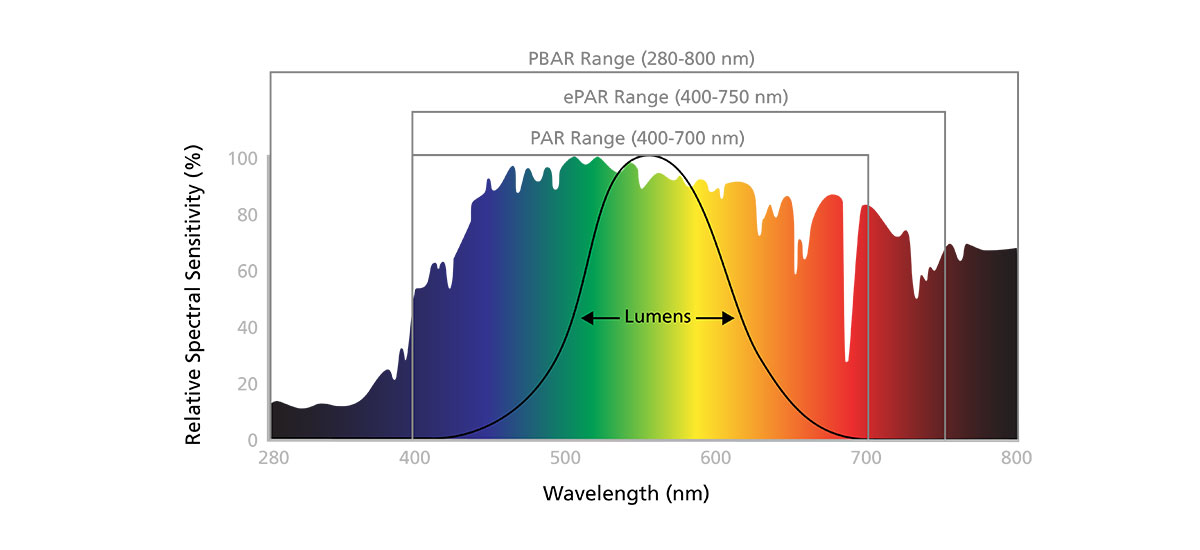Horticultural Terms
Finding the right horticultural lighting solutions for your operation starts with understanding what your plants need. As you search for grow light systems, you’ll come across a variety of terms and metrics from manufacturers. When we talk about horticultural lighting, we are focused on metrics related to how plants use energy (PPF, PPFD, etc.) rather than measuring light output by what is visible to the human eye (lumens, CRI, etc.)
Below, we’ve provided an overview of common horticultural terms and how they impact your horticultural lighting system.
Photosynthetic Response Versus Human Eye Response

PAR (Photosynthetically Active Radiation)
PAR describes the spectrum of light that supports photosynthesis in plants (400-700 nm). PAR simply describes the waveband utilized during the process of photosynthesis. It is not a measurement or metric for light.
ePAR (400 – 750nm)
ePAR is a new measurement range (400-750 nm), incorporating far red light. This range was developed in response to research indicating that there is also substantial plant and photosynthesis responses from light outside the classic PAR range, especially from far red light. The new ePAR measurement range (400 – 750nm) addresses these additional photons.
PBAR (Plant Biologically Active Radiation)
PBAR is the spectrum of light (280-800 nm) that affects all plant biology. This includes the PAR band (400-700 nm), the ePAR band (400-750 nm) as well as ultraviolet and far-red ends of the spectrum.
PPF (Photosynthetic Photon Flux)
PPF is a measurement of how much light within the PAR spectrum is emitted from a light source per second (expressed in micromoles of photons per second: µmol/s). In other words, this metric is important to compare how much light will be usable for photosynthesis from various horticultural lighting fixtures.
PPFD (Photosynthetic Photon Flux Density)
Whereas PPF is only measured at the light source, PPFD measures the amount of light within PAR that actually falls on a plant canopy area per second. This measurement is expressed in micromoles of photons per square meter per second (µmol/m2/s). This is measured with a PAR Light Meter or specifically calibrated spectrometer.
DLI (Daily Light Integral)
DLI refers to the amount of PAR-range photons that land on a target area during a 24-hour period. This measurement is expressed in moles per square meter per day (mol/m2/d). DLI requirements will vary by plant type.
Daylight Harvesting
Daylight harvesting is the practice of automatically adjusting the brightness from a light source in response to the amount of natural light provided in a space. This strategy helps reduce energy consumption while ensuring that crops receive the amount of light they need to grow as expected.
Supplemental Lighting
Supplemental lighting is used in settings such as a greenhouse to augment the total amount of light that plants receive (in addition to natural daylight). Supplemental lighting fixtures help keep production schedules on target if there are periods of low natural light.
Efficacy
Efficacy describes a light source’s efficiency of converting electrical energy into PAR light. This measurement is expressed in micromoles per Joule (µmol/J). This is a helpful metric for comparing horticultural lighting fixtures from different manufacturers.
HPS (High Pressure Sodium)
HPS lamps are high-intensity fixtures that emit large amounts of light with a wide color-temperature spectrum. These have been a popular fixture type among indoor growers. Newer LED technology is comparatively more energy efficient and requires less maintenance.
DLC® Horticulture Listed
The DesignLights Consortium® (DLC) is a non-profit organization committed to improving energy efficiency for commercial lighting throughout North America. The DLC’s Horticultural Qualified Products List is a collection of lighting instruments that meet technical requirements set by the DLC. This listing helps growers find efficient lighting options for indoor agriculture.
L90
An L90 rating describes how long a fixture can be expected to provide an acceptable level of intensity. L90 specifically refers to how long it will take a fixture to only be able to produce 90% of the brightness that it initially could out of the box.